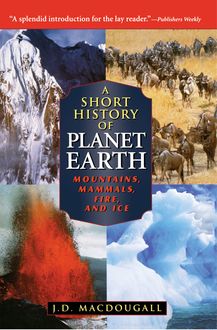A Short History of Planet Earth , livre ebook
158
pages
English
Ebooks
2008
Vous pourrez modifier la taille du texte de cet ouvrage
Obtenez un accès à la bibliothèque pour le consulter en ligne En savoir plus
Découvre YouScribe en t'inscrivant gratuitement
Découvre YouScribe en t'inscrivant gratuitement
158
pages
English
Ebooks
2008
Vous pourrez modifier la taille du texte de cet ouvrage
Obtenez un accès à la bibliothèque pour le consulter en ligne En savoir plus
Publié par
Date de parution
02 mai 2008
Nombre de lectures
0
EAN13
9780470341308
Langue
English
"A splendid introduction to geology and paleontology for the lay reader. To compress Earth's history into a single, lucidly written volume is a major achievement." —Publishers Weekly, starred review
"Few people have both the knowledge and the writing ability to capture such a long and varied history in a compelling manner. In A Short History of Planet Earth, J.D. Macdougal demonstrates that he is one of the few." —Earth
This exhilarating survey of the four and half billion years of Earth's history charts both the geological and biological history of the planet. It moves from the origin of the earth's iron core to the formation of today's seven continents, and from the primordial building blocks of life to the evolution of the human form.
Reading the Rocks.
Early Days.
Wonderful Life.
The Proterozoic Eon.
Dance of the Plates.
Nature's Timepieces.
The Cambrian Explosion.
Fish, Forest, and Gondwanaland: The Paleozoic Era.
From Pangea to (Almost) the Modern World: The Mesozoic Era.
Global Catastrophes.
Mammals, Mountains, and Ice: The Cenozoic Era.
The Great Ice Age.
What Comes Next?: Geology and Man.
Glossary.
Further Reading.
Index.
Publié par
Date de parution
02 mai 2008
Nombre de lectures
0
EAN13
9780470341308
Langue
English
A SHORT HISTORY OF PLANET EARTH
Mountains, Mammals, Fire, and Ice
WILEY POPULAR SCIENCE
J OHN W ILEY S ONS , I NC.
New York Chichester Weinheim Brisbane Singapore Toronto
For Sheila, Christopher; and Katherine
This text is printed on acid-free paper.
Copyright 1996 by J. D. Macdougall
Published by John Wiley Sons, Inc.
All rights reserved. Published simultaneously in Canada.
Reproduction or translation of any part of this work beyond that permitted by Section 107 or 108 of the 1976 United States Copyright Act without the permission of the copyright owner is unlawful. Requests for permission or further information should be addressed to the Permissions Department, John Wiley Sons, Inc.
This publication is designed to provide accurate and authoritative information in regard to the subject matter covered. It is sold with the understanding that the publisher is not engaged in rendering legal, accounting, or other professional services. If legal advice or other expert assistance is required, the services of a competent professional person should be sought.
Library of Congress Cataloging-in-Publication Data
Macdougall, J. D.
A short history of planet earth: mountains, mammals, fire, and ice / J.D. Macdougall.
p. cm.
Includes bibliographical references and index.
ISBN 0-471-14805-9 (cloth: alk. paper) /
ISBN 0-471-19703-3 (paper: alk. paper)
1. Historical geology. I. Title.
QE28.3.M33 1996
551.7-dc20
95-46399
Printed in the United States of America
10 9 8 7 6 5 4
CONTENTS
Preface
Acknowledgments
CHAPTER 1 Reading the Rocks
CHAPTER 2 Early Days
CHAPTER 3 Wonderful Life
CHAPTER 4 The Proterozoic Eon
CHAPTER 5 Dance of the Plates
CHAPTER 6 Nature s Timepieces
CHAPTER 7 The Cambrian Explosion
CHAPTER 8 Fish, Forests, and Gondwanaland: The Paleozoic Era
CHAPTER 9 From Pangea to (Almost) the Modern World: The Mesozoic Era
CHAPTER 10 Global Catastrophes
CHAPTER 11 Mammals, Mountains, and Ice: The Cenozoic Era
CHAPTER 12 The Great Ice Age
CHAPTER 13 What Comes Next? Geology and Man
Glossary
Further Reading
Index
PREFACE TO THE PAPERBACK EDITION
The earth is a dynamic planet. And, like the planet, the field of earth sciences is constantly evolving. In the two years since the hardcover edition of this book went to press, old ideas have been refined and many new discoveries have been made about the earth and our neighboring planets. Some of these have come from fieldwork-for example, the discovery of a new type of mammalian fossil in Australia, which is prompting reexamination of the entire timescale of mammalian evolution-and some have come from the ever higher resolution and precision with which the earth is being probed by new, more sophisticated instruments.
In a short preface it is impossible to do justice to the many important findings that have impacted the earth sciences over the past few years. But I would like to point out a few that are directly relevant to themes discussed in this book. One involves the comet Hale-Bopp, which appeared in April and May of 1997, awing hundreds of millions of people around the globe. It was a milestone in confirming both the role of impacts on our planet and the importance of comets as carriers of molecules that were likely the precursors of life on earth.
Hale-Bopp was a once-in-a-lifetime event, bright enough to be seen even through the light pollution of New York City or London. Its diameter was 30 to 40 km-three or four times the diameter, or thirty to sixty times the volume, of the impactor that was at least partly responsible for the mass extinction at the end of the Cretaceous period. Although Hale-Bopp passed close to us, there was no danger of collision. But other objects of this size have crashed into the earth with almost unimaginable consequences. Furthermore, as Hale-Bopp approached the sun and warmed up, it spewed off huge amounts of volatile materials that were observed by astronomers-including water and a long list of molecules such as formaldehyde and methyl cyanide. Such compounds have been observed in molecular clouds far beyond our solar system; Hale-Bopp showed that comets could deliver them to the inner planets, strengthening the argument that organic molecules from space were important for the development of life on earth.
Other findings from the past few years have also led to significant advances in understanding in the earth sciences: Chemical fossils discovered in ancient sedimentary rocks have pushed back the earliest evidence for life on earth by almost 400 million years, to at least 3.85 billion years ago. Studies of seismic waves passing through the earth s metallic core indicate that the inner (solid) part of the core is spinning faster than the earth s surface. This has important implications for the magnetic field. Examination of written records from Japanese coastal villages, together with studies of tree rings in Washington and Oregon, indicate that a gigantic earthquake struck the Pacific Northwest subduction zone in the year 1700, sending a huge tsunami across the Pacific. This knowledge raises concern about seismic safety in this now heavily populated region. The precise timing of earth s largest mass extinction event, at the end of the Paleozoic era, has been determined by careful study of fossil populations coupled with high-resolution dating of zircon crystals from rocks on either side of the boundary. The extinctions were very abrupt, lasting only a few hundred thousand years; this evidence puts strong constraints on the possible extinction mechanisms.
Although we have learned much about the earth and its history, we have really only scratched the surface. The search for knowledge about how our planet works will occupy us for a very long time to come.
ACKNOWLEDGMENTS
A book like this owes much to many people. I am especially grateful to my colleagues-associates, students, and friends, past and present-at the Scripps Institution of Oceanography, from whom, over the years, I have learned a great deal. They have provided Scripps with an atmosphere in which exploration and learning take place every day. Without that ambiance, I m not sure this book would ever have been started, or my enthusiasm for it sustained.
At home, Sheila Macdougall endured many dull evenings and weekends without much complaint as this was being written, for which I am ever grateful. Christopher and Katherine were guinea pigs for the raw manuscript, and declared that it could both be read and made sense of by nonscientists, and didn t immediately put them to sleep.
Al Levinson, encouraging throughout, read parts of the manuscript and made many useful suggestions. Rick Balkin was a great help and encouragement at many steps along the way, for which I am very grateful. Guy Tapper drew or reproduced all of the illustrations with professionalism and within a short time frame, and his efforts add considerably to the book. At Wiley, Emily Loose enthusiastically endorsed this project, and shepherded the manuscript over various hurdles, ensuring its timely appearance. To all of you, my thanks.
1
READING THE ROCKS
In the middle of the seventeenth century, James Ussher, a widely respected scholar and prelate of the Anglican Church in Ireland and England, calculated that the earth was created in the year 4004 B.C. He arrived at this conclusion by careful study and literal interpretation of the genealogies in the Bible. In the time-honored tradition of research, other scholars of his day-themselves not having devised any alternative methods for finding the earth s age-checked Ussher s calculations. He got the year right, they declared, but it was possible to be more precise: The earth was created at 9 A.M. on October 23, 4004 B.C!
Today some university geology departments, with tongue-in-cheek deference to Ussher, hold birthday celebrations for the earth on October 23. But in fact, the earth is nearly a million times older than the Reverend Ussher calculated. Its real age is 4.5 billion years, although it was more than a century after Ussher s writings were published that geologists began to realize the true immensity of geologic time.
Our planet is thus incredibly old by human standards: Four and a half billion years is a stretch of time that has no relevance to human experience. Geologic timescales are so vast that only by analogy can we glean some understanding of the seemingly infinite stretch of time between us and the creation of Earth. One such analogy presents the history of the earth as a three-hour movie. We-as a species, not you and I personally-would make a cameo appearance in the last second or so. This book, like the three-hour movie, is a very abbreviated journey through that history, from the formation of the solar system to the present. It is arranged chronologically, with occasional diversions to discuss topics that are important for understanding the history. But the reader should be warned that it touches only some of the highlights. One could easily consume several lifetimes mastering all of the details of the earth s fascinating past.
For most of us, the natural landscape has a degree of permanence. Barring calamities such as volcanic eruptions or large earthquakes, the geologic panorama really doesn t change perceptibly in a human lifetime. But the earth in its lifetime has witnessed extraordinary transformations. Over the billions of years of its existence, our planet has endured global catastrophes on a scale unequaled in human experience, has seen the rise and fall of countless species that no longer grace the earth, and has watched entire ocean basins and mountain ranges form and then disappear. How do we know such things? Some of our understanding comes from laboratory experiments and from mathematical simulations of geologic processes, or even from intelligent speculation, but much of it comes from the rocks. Rocks are the recorders of the earth s history, and hold the

